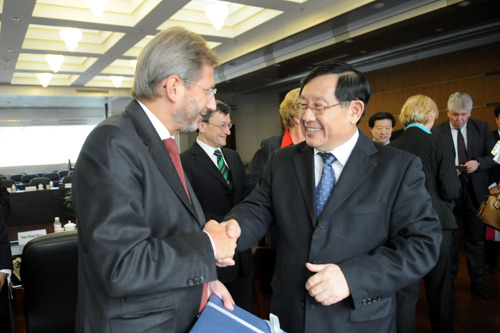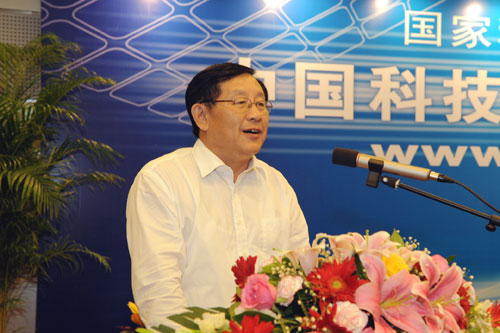|
CHINA SCIENCE AND TECHNOLOGY
NEWSLETTER
The Ministry of Science and Technology
People's Republic of China
|
|
|
N0.560 |
September 30, 2009 |
|
|
|
|
|
|
|
|
IN THIS ISSUE
|
|
*Chinese Marine Medicine Book
*Chinese S&T Minister Met His Austrian Counterpart
*China-Denmark Nanometal Center
*Auto Wind Tunnel
*China Finds Dinosaur with Four Wings
*Potato Genome Draft Sequence
|
Chinese Marine Medicine Book
Chinese Marine Medicine, the first domestic book describing marine medicines in the country, has been published in Beijing. It takes five years for the writers to complete the works, the most comprehensive analysis of marine medicine resources in China.
The book is made up of 9 volumes under the sub-titles of Marine Medicinal Organisms and Marine Natural Products. It has collected marine medicine information in 14 million Chinese words from more than 500 historical writings and over 50,000 citations from contemporary journals. It covers 613 marine drugs, 1,479 species enjoying medicinal potentials, and 15 minerals, along with detailed descriptions of their chemical constituents and pharmacological/toxic properties. Marine Medicinal Organisms has collected more than 300 typical marine creatures and associated biological, chemical, and pharmacological information, providing basic evidences for studying and developing natural marine products and drugs in the future. Marine Natural Products has gathered the data and information on the origin, structure, and biological activity of more than 20,000 compounds derived from the contemporary study of marine natural products since the early 20th century, making itself a useful tool for study marine natural products.
Chinese Marine Medicine is a book telling the civilization of marine drug development in both ancient times and today, and is a useful guidance for diseases prevention and treatment. It will become a useful tool for tapping up traditional medicinal theory, clinical marine drug application, and modern marine drug studies.
|
INTERNATIONAL COOPERATION |
Chinese S&T Minister Met His Austrian Counterpart


WAN Gang, Chinese Minister of Science and Technology, held a talk with Johannes Hahn, the visiting Austrian Federal Minister for Science and Research on September 25, 2009 in Beijing. Both sides reviewed the S&T cooperation conducted between the two countries, and exchanged views on raising the cooperation level in the future.
Both ministers agreed that the joint S&T cooperation committee mechanism has played an important role in bilateral S&T cooperation activities, and has facilitated the exchanges of researchers in the two countries and the implementation of cooperation projects in a steady and effective manner. In recent years, the academic activities sponsored by both sides in the area of energy, traditional Chinese medicine, and innovation policies have deepened the mutual exchanges.
WAN said the Chinese government has made scientific research and technology innovation in the area of climate change a priority. Energy efficiency and emission reduction, and adaptation to climate change impacts is an issue calling for international cooperation. The Chinese government is willing to work with other countries, including Austria, in the area. Hahn expressed that he and his government has paid great attention to the cooperation with China in the area of science and technology, and will continue to strive for more collaboration, especially under the EU framework.
China-Denmark Nanometal Center
A China-Denmark Nanometal Research Center was put into operation on September 14, 2009 at Risø- DTU in Denmark. The lab, jointly financed by DNRF and NSFC, is operated by a team of scientists coming from Risø- DTU, CAS Institute of Metal Research Shenyang National Lab, Tsinghua University, and Chongqing University. The lab will mainly work on the structural performance of nanometals, including preparation, processing, structural features/stability/dynamics and physical/chemical properties. Researchers will study the feasibility of applying the basic theory of regular materials in nanometals, and establish a new nanometal theory as well, creating the theoretical basis for developing advanced metals of improved dynamic and physical performance. According to a plan, researchers from China and Denmark will work together at different levels, making the center an important platform for nanometal related collaborative researches between the two countries.
Auto Wind Tunnel
Thanks to 5-year construction efforts, China’s first auto wind tunnel, built by Tongji University, was put into operation on September 19, 2009 at the Tongji University campus in Jiading, Shanghai. WAN Gang, Chinese Minister of Science and Technology, opened the auto wind tunnel at the inauguration ceremony.
The auto wind tunnel is a multifunctional system built for theoretical and applied studies, including whole-vehicle wind tunnel, auto shaping, processing, equipment maintenance, R&D, and management. It, together with other advanced facilities in its vicinity, including Tongji University’s new energy auto engineering center, Shanghai auto quality test center, and auto test lot, makes up an internationally advanced ground transport tool test center. According to a briefing, the wind tunnel simulates the natural environment in which vehicles may drive through, including air resistance, noise, thermodynamics, temperature, humidity, and solar radiation, allowing researchers to test the safety, reliability, and energy efficiency of new prototype automobiles.
Rail Traffic Experimental Line

A more than 1000-m long rail traffic experimental line was put into operation on September 19, 2009 at the premises of Tongji University in Jiading. A two-compartment experimental vehicle made its test run on the line. The test line makes a public platform to develop proprietary core technologies for building new urban rail traffic equipment. WAN Gang, Chinese Minister of Science and Technology, was present at the event.
The test line system, made up of a 2.1km long rail traffic experimental line, an experimental vehicle, and a comprehensive lab, was built by Tongji University. The experimental line will be further extended in both east and west directions, allowing a maximum test speed reaching 120km per hour. The test line will be connected to No.11 municipal rail line in Shanghai, and become part of the subway networks of the city.
China Finds Dinosaur with Four Wings

A team of archaeologists, headed by Prof. HU Dongyu at Shenyang Normal University, unearthed the fossil of a bird-like dinosaur with four wings in Linglongta, Jianchang County, Liaoning Province. Researchers reported the finding of the earliest bird-like dinosaur with wings so far discovered in September 25 online issue of Nature, and the printed October 1 issue of Nature, showing a missing link in dinosaurs' evolution into birds.
Researchers have found for the first time in the world that the well-preserved fossil shows the clear feather signs around its skeletons, with strange looking feathers covering the four limbs and tails. They even found feathers on phalanx.
According to a briefing, the "Anchiornis huxleyi", which roamed the earth some 160 million years ago, has advanced the history of feathered dinosaur fossils by 20 to 30 million years, or at least several millions years for the existence of archaeopteryx. Apparently, the finding has provided a powerful evidence to show that birds originated from theropoda. Comparing with the archaeopteryx found in Germany, Anchiornis huxleyi had smaller and finer feathers in symmetric patterns, with rounded tips, reflecting a more primitive nature. Researchers believe that the feet feathers, possessed by Anchiornis huxleyi, represent an original pattern implying dinosaurs' evolution into birds, though not ready for flying. In addition, the feather covered long legs are rarely seen among the animals that are built for running.
Clearest 3-D Moon Picture in the World
A 3-D lunar picture, derived from China’s moon probe project, passed experts’ review on September 28, 2009. Experts who are part of the review rated the picture “a 3-D lunar picture that enjoys the highest surface and elevation resolution and data accuracy, allowing more accurate study of the features, patterns, and attributing causes of the lunar surface, and providing solid scientific evidences for understanding the lunar composition and associated zoning”. The effort also creates an important basis for understanding the geological and evolution history of the moon, and for getting prepared for the future moon probe.
China launched its first moon probe, Chang’e I satellite, on October 24, 2007. It carries a CCD scanning camera able to collect imaging data from three different angles in 85 seconds. Chinese scientists used the data derived from the camera to map up 3-D lunar terrains using special techniques. The published lunar picture shows a spherical surface 1737.4 km in radius, with a spatial resolution of 500m, and surface and elevation errors at 192m and 120m respectively.
Potato Genome Draft Sequence
The Potato Genome Sequencing Consortium, an international team of scientists from 14 countries, announced on September 23, 2009 the completion of the first draft sequence of the potato genome in Beijing, Amsterdam, London, New York, and Lima simultaneously. The draft was mainly completed by the Chinese team consisting of the scientists from the Chinese Academy of Agricultural Sciences and Beijing Genomics Institute (Shenzhen).
According to a briefing, Dr. HUANG Sanwen, the lead scientist of Chinese team, proposed a new scheme to reduce the complexity of genome analysis, along with improved DNA sequence techniques that cut down the sequence cost. The new strategy has advanced the completion of sequence efforts by two years, allowing Chinese scientists being a leader in the process. The completed sequence is estimated to be 12 chromosomes and 840 million base pairs. The draft sequence has covered 95 percent of potato genes.
Enhanced Magnetic Resonance Imaging
Time Medical Inc., located in Shanghai Zhangjiang High Tech Park, announced September 24, 2009 that its proprietary High Temperature Superconducting (HTS) RF Coil technology has raised the resolution and clarity of human imaging by 3 to 5 times. The coil was preliminarily tested on humans in August at University of California School of Medicine in San Diego and University of Pittsburgh School of Medicine separately, showing an enhanced sensitivity and clarity by 300% to 500%. The new technology is able to make a low-field MR system to yield a high-field effect, without the enhancement of magnetic field intensity, which raised the clarity of human imaging by a large margin.
S&T Resources Sharing Network




A China S&T resources sharing network, jointly established by the Chinese Ministry of Science and Technology and Ministry of Finance, was opened on September 25, 2009 in Beijing. The event marks an important move to build a national S&T resources infrastructure focusing on information and network technology. Open to the society, the platform, made up of S&T information databases, dynamic S&T information flows, platform construction findings, S&T resources navigation, will provide S&T resources navigation and tailored services to both S&T personnel and the public. Clients may access other S&T resources networks through a registration process, obtaining a range of services provided by resources providers, including prearranged use of large scientific instruments, standard documents, and germplasm resources.
Chinese Standard for High Definition Disc
China High Definition Disc Promotion Alliance announced on September 17, 2009 the birth of the new generation DKAA series high definition products that enjoy Chinese audio-video standards, and are protected by copyright laws. The socalled China Blue Light high definition discs in CBHD format and associated players and flat panel TV sets were displayed on the show staged on the day. A dozen of high definition home made and overseas movies in CBHD formats were shown to the audiences. According to a briefing, the CBHD optic disc can be read by the blue laser at a wavelength of 405 nanometers with an enhanced efficiency. The disc is designed with two specifications for both 15GB and 30GB.
Comments or inquiries on editorial matters or Newsletter content should be directed to:
Department of International Cooperation, MOST 15B, Fuxing Road, Beijing 100862, PR China Tel: (8610)58881360 Fax: (8610) 58881364
http://www.most.gov.cn |

